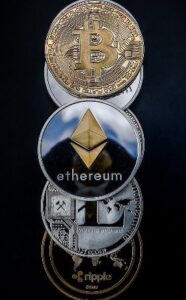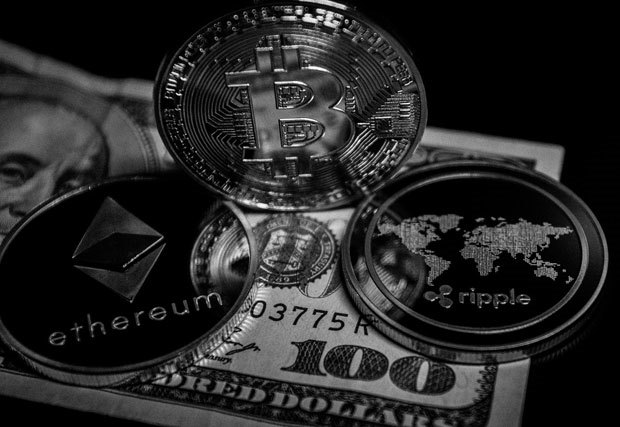Due to the lack of security, transparency, and efficiency of centralized finance, a strong demand for decentralized finance (DeFi) has surfaced. William Quigley believes this emergence of decentralized peer-to-peer financial platforms, will end central banking as we know it. Thanks to blockchain technology, and scores of new actors that are developing decentralized technologies, we are moving toward a trustless economy, where P2P marketplaces allow individuals to remain the sole custodian of their own assets, with no need for third parties.
William Quigley – a venture capitalist in California and co-founder of WAX (Worldwide Asset eXchange).
What Is Decentralized Finance (DeFi)?
 Decentralized finance refers to a monetary system of peer-to-peer (P2P) finance. DeFi is enabled by smart contracts – transaction protocols and applications built on a blockchain platform, that are intended to execute automatically when certain conditions are met. Blockchain platforms are typically open source, allowing anyone to create and verify financial applications. And as with LEGO bricks, decentralized applications (DApps) can be plugged together. Such transparency and interconnectivity helps facilitate a comprehensive mix of financial activity including lending, borrowing, saving, purchasing insurance coverage, structuring derivative products, the buying and selling of securities, and more. The vast majority of DApps are currently created on the Ethereum blockchain, but in principle, applications can be built on any blockchain platform with smart contract capabilities.
Decentralized finance refers to a monetary system of peer-to-peer (P2P) finance. DeFi is enabled by smart contracts – transaction protocols and applications built on a blockchain platform, that are intended to execute automatically when certain conditions are met. Blockchain platforms are typically open source, allowing anyone to create and verify financial applications. And as with LEGO bricks, decentralized applications (DApps) can be plugged together. Such transparency and interconnectivity helps facilitate a comprehensive mix of financial activity including lending, borrowing, saving, purchasing insurance coverage, structuring derivative products, the buying and selling of securities, and more. The vast majority of DApps are currently created on the Ethereum blockchain, but in principle, applications can be built on any blockchain platform with smart contract capabilities.
Benefits Of Decentralized Finance
Why does William Quigley consider decentralized finance to be such a big deal? In general, he believes that DeFi has the ability to address the current limitations and failings of centralized financial institutions which are encumbered by customer restrictions, censorship, single points of failure, corruption, and high fees.
According to Quigley, some of the key benefits that will help DeFi disrupt centralized banks, are as follows…
Permissionless
Unlike traditional finance, DeFi is defined by its open, permissionless access: anyone with a crypto wallet and an Internet connection, regardless of their geography and often without any minimum amount of funds required, can access DeFi applications.
Okay, for starters, anyone with an internet connection and a smartphone can now access valuable financial services. Financial services delivered across borders without interruption.
Immutability Helps Unlock Liquidity
Tamper-proof data coordination across a blockchain’s decentralized architecture increases security and auditability, which creates the ability for holders of digital assets to borrow against those assets.
Another wonderful aspect of DeFi is creating fungible collateral out of the digital assets you own and to do that, the next step is being able to borrow against those assets. There really is no other way to do this but on a blockchain because only on a blockchain can everyone be certain that the digital asset you’re pledging as collateral are genuine. Now that fact, the ability to near instantly validate an asset as authentic, is a powerful part of the DeFi story. Remember, gold doesn’t self-identify. It doesn’t say that everyone and say, “look at me, I’m gold and I’m good collateral.” How do you know if someone pledging a box of metal if giving you gold? Well you don’t unless you do a lot of work to test it and then safeguard it. DeFi digital assets don’t have that issue and because these blockchain digital assets can be quickly and cheaply certified as authentic, you can get equity on those assets much faster than ever possible in the traditional finance world.
Increased Transparency
DeFi applications are open source. Open source coding refers to the fact that the coding is made public. In this way, not only does it create opportunities for rich data analysis, but anyone can audit it and validate its functionality, security, and capabilities. This provides more confidence in the platform because users can rest assured that no hidden malicious coding is operating in the background.
A couple of other wonderful things of DeFi, all the collateral lending contracts you enter into are fully transparent. They’re fully transparent because they’re software code. Code that has been reviewed and scrutinized or written about in forms and blogs for everyone to see, nothing is hidden. Now compare that to modern banking.
Self-Custody Eliminates Risk To Taxpayers
Since DeFi is peer-to-peer (P2P), using Web3 wallets like MetaMask to interact with permissionless financial applications and protocols, DeFi market participants always keep custody of their assets and control of their personal data. This eliminates the deposit insurance risk that is incurred by the taxpayer.
With centralized banking, on the other hand, bank runs are a common feature in monetary history. During a bank run, depositors rush to withdraw their deposits because they expect the bank to fail. The sudden withdrawals can force the bank to liquidate many of its assets at a loss and to actually fail. In the US (and in most other countries), the government guarantees that if a bank fails, the customers of that bank will be able to claim a certain percentage of their deposit back from the government. This shortfall that’s covered by the “deposit insurance”, comes out of the taxpayers’ pockets.
One other aspect of DeFi I like is fact it’s not dependent on taxpayer insured banking deposits. This is not fractional reserve banking. There is no credit risk taxpayers are knowingly backstopping.
Elimination Of Middlemen And Extra Fees
Use of smart contracts removes the need for the middleman, the extra paperwork, and all the extra fees that rob productive capital from the lender and the borrower.
You might also like the fact that DeFi more fairly distributes to the gains of finance. You can play the role of banker, you can both borrow and lend and be treated fairly in the process.
DeFi Is Self-Reliant
Thanks to highly programmable smart contracts that automate execution, and the ability to build third-party applications on top of existing protocols, DeFi is a self-reliant system, completely independent of outside institutions.
Lastly, what I really like about DeFi is that its serving the crypto community. DeFi isn’t preoccupied with trying to convince big existing companies to think about, to consider, maybe adopt blockchain technology. This is only the second time I’ve seen this happen. The crypto community has created something for itself. Now the first time was the stable coin, and by the way, this is how the consumer internet developed in the first five years after the mosaic browser. The internet community looked inward at itself, at people who would have already joined the bandwagon, serving and acquiring internet users and internet businesses. They didn’t worry about old school retailers and newspapers and media companies that were sitting on the fence. And it worked. The growth in DeFi is going to work the same way.
Prospective Applications Of DeFi
Thanks to a wholesale and integrated effort to build a comprehensive financial system that rivals the centralized banking system, DeFi is hastening a new era of economic activity and opportunity for users around the world.
A comprehensive list of use cases is listed below…
Asset Management
Crypto wallets like MetaMask, Gnosis Safe, and Argent enable you to be the custodian of your own crypto funds, while easily and securely interacting with all the other decentralized applications.
Compliance
 In DeFi, a decentralized open source blockchain enables next-generation compliance analysis around the behavior of participating addresses rather than participant identity. These know-your-transaction (KYT) mechanisms help assess risk in real time and protect against fraud and financial crimes.
In DeFi, a decentralized open source blockchain enables next-generation compliance analysis around the behavior of participating addresses rather than participant identity. These know-your-transaction (KYT) mechanisms help assess risk in real time and protect against fraud and financial crimes.
DAOs
A decentralized autonomous organization (DAO) is a community of members that cooperate with each other according to transparent, self-enforcing rules encoded on a blockchain. Members are not bound together by a legal entity, nor have they entered into any formal legal contracts. Instead, they are steered by incentives tied to the network tokens, and fully transparent rules that are written into the piece of software, which is enforced by machine consensus. There are no bilateral agreements. There is only one governing law – the protocol or smart contract – regulating the behavior of all network participants, thus eliminating the need for a centralized, administrative entity.
Data and Analytics
Thanks to DeFi’s unprecedented transparency around transaction data and network activity, DeFi protocols offer exciting opportunities for data discovery, analysis, and decision-making around financial opportunities and risk management.
Derivatives and Synthetic Assets
Blockchain-based smart contracts enable the creation of tokenized derivative products (options, futures and swaps), whose value is derived from the performance of an underlying asset (stocks, bonds, commodities, indexes, currencies or interest rates). By using these unique “synthetic assets”, in which counterparty agreements are hardwired in code, investors can hold tokens that track the value of the underlying assets without needing to leave the cryptocurrency ecosystem.
Understanding that the derivatives market is bigger than the global real estate, stock, debt and gold markets combined, synthetic assets are one branch of the DeFi space that should attract a lot of attention in the years ahead.
Decentralized Exchanges (DEXs)
Thanks to DeFi, cryptocurrency exchanges can operate without a central authority, allowing users to transact peer-to-peer and maintain control of their funds. Since crypto assets are never in the custody of third party exchanges, DEXs reduce the risk of price manipulation, hacking and theft. And since there’s no middleman – no centralized exchange – token projects can attain access to liquidity, without any listing fees.
Gaming & Prediction Markets
Games can use innovative incentive models (like no-loss sweepstakes that pay out accrued interest when the pooled fund is lent to a money market protocol). Blockchain-based prediction markets, on the other hand, can harness the wisdom of the crowd by enabling users to vote and trade value on the outcome of events (election results, sports games, economic events, etc.).
Identity
Instead of conventional data points such as home ownership and income, innovative DeFi applications will be able to help assess a person’s creditworthiness via attributes related to reputation and financial activity. DeFi values data privacy around personal identity, while maintaining open access to transcriptional data. In this way, DeFi applications will reduce the collateralization requirements for someone lacking funds, and simultaneously allow the individual to maintain control of their data and assets (protecting them from the vulnerabilities of a centralized system).
Insurance
Using smart contracts, users will be able to buy coverage and protect their holdings with innovative insurance alternatives that help policyholders save on premiums due to the elimination of the middleman.
Lending and Borrowing
Peer-to-peer (P2P) lending and borrowing protocols are among the most popular applications in the DeFi ecosystem today. Smart contracts can automatically match borrowers and lenders, then calculate interest rates based on the ratio of borrowed to supplied assets. And as a consequence of providing interest rate markets on the blockchain, DeFi lending platforms can allow users to earn interest on crypto that they’ve supplied to the lending pool.
Libraries Of Tooling & Security Integrations
Since one of the core design principles of DeFi protocols is composability (meaning different components of a system can easily connect and interoperate), developers can access and build upon applications built by others, creating a powerful network effect.
Margin Trading
Rather than leveraging trades by borrowing funds from a broker, like in traditional finance, DeFi margin trading utilizes decentralized, non-custodial lending protocols to automate brokerage activity. The use of such smart contracts and elimination of the broker – the middleman – has earned DeFi margin trading the moniker “autonomous money markets”.
Marketplaces
The next logical step for online marketplaces is the use of DeFi protocols that allow traders on decentralized exchanges to benefit from lower exchange fees, faster transaction settlement, and full custody of their assets. Already such marketplaces facilitate the exchange of digital products and services across borders and P2P. This includes an ever-growing and integrated network of decentralized exchanges and liquidity pools that facilitate everything from derivatives trading, to margin trading, to token swaps. And it won’t be long until applications using escrow smart contracts will be launched, helping to securely exchange physical goods as well.
Payments
Peer-to-peer (P2P) payment is no doubt the primary use case of the DeFi space and of the blockchain ecosystem as a whole. Blockchain is specifically designed so that users can exchange cryptocurrency securely and directly with one another, without middlemen. And as time goes on, DeFi payment solutions and streamlined market infrastructure will get better and better at serving customers (including underbanked populations), service providers, retailers and wholesalers. Truth is, in the not-so-distant-future, the speed of innovation and the ease of use of DeFi payment solutions, will probably outpace and overtake that of legacy centralized payment platforms.
Savings
Instead of simply holding cryptocurrencies in anticipation of capital appreciation, you can now utilize lending pool protocols to earn interest on your crypto holdings. Such DeFi applications pay out a dynamic interest rate that’s tied to supply and demand, and in most cases, this interest rate is far superior to anything you can get in a fiat savings account at a conventional bank.
Another innovative savings mechanism is yield farming. Also known as liquidity mining, yield farming protocols allow DeFi users to generate rewards with their idle crypto assets by providing liquidity for a specific token and exchange. Liquidity mining is similar to Bitcoin mining in that miners run open source software on their own computers and use their own scarce resources (inventory of crypto assets).
Stablecoins
A stablecoin is any cryptocurrency that is pegged to another asset with a stable value. Since volatility prevents the widespread adoption of cryptocurrencies as a store of value, stablecoins were developed to reduce volatility and help crypto assets reach a wider audience. Types of stablecoins include commodity backed stablecoins (backed by hard assets such as precious metals or real estate), fiat backed stablecoins, crypto backed stablecoins, as well as non-collateralized stablecoins (the underlying basis for central bank digital currencies). Now quite pervasive in decentralized finance, use cases include remittance, commerce, salaries, rents, lending, prediction markets, trading, wealth management, and store of value.
Staking
Staking is the process of actively participating in transaction validation (similar to mining) on a proof-of-stake (PoS) blockchain. It is a less resource-intensive alternative to mining via proof-of-work (PoW), the consensus protocol used by cryptocurrencies like Bitcoin. Staking involves holding funds in a cryptocurrency wallet to support the security and operations of a blockchain network. In simple terms, its the act of locking in cryptocurrencies to receive rewards.
Some might argue that the production of blocks through staking enables a higher degree of scalability for blockchains. This is one of the reasons the Ethereum network is migrating from PoW to PoS in a set of technical upgrades collectively referred to as Ethereum 2.0 (ETH 2.0).
Tokenization
Cryptographic tokens are programmable digital assets that are created, issued, and managed on a blockchain. Designed to by secure and instantly transferable, they represent units of value in the form of money, coins, points, digital items, or representations of real-world physical items and rights. Use cases are extensive. They range from real estate security tokens that represent fractionalized ownership, to platform-specific tokens that incentivize the use of a particular application.
Tokens can only be accessed with a private key for the address holding the tokens, and can only be authorized via this private key. Therefore, whoever is in possession of the private key, is essentially the owner of those tokens.
There are four main types of tokens.
- payment tokens (cryptocurrencies)
- utility tokens
- asset-backed tokens (security tokens)
- non-fungible tokens (NFTs)
Conclusion
While DeFi is still in its infancy, and many of its prospective applications are yet to be fully realized, William Quigley clearly believes that disruption to centralized banking is just around the corner.
Final thought here, what about the word “decentralized” in decentralized finance? I judge decentralized or decentralization based on one key principle: Would the systems still work if the original application builders went away, dissolved and the infrastructure they managed was turned off? Today I don’t know of any DeFi applications that meet that standard, but that is going to change. The way we create, trade and now collateralize digital assets on chain is going to dramatically improve next year, in 2020.
DeFi Investment Opportunities
Use cases for decentralized finance are growing all the time. And if the end game of DeFi is the disruption of centralized banking, growth in the space should be explosive (but volatile) and continue for quite some time. Below are some of the more popular ways to invest (and speculate) in decentralized finance.
Investing In Cryptocurrencies (Crypto Coins)
 Cryptocurrencies can take the form of native blockchain tokens like bitcoin (BTC), or can also be built on the Ethereum blockchain as ERC-20 tokens. Regardless if they are on a native blockchain or on the Ethereum blockchain, the key purpose of a cryptocurrency is to act like money: as a unit of account, store of value and medium of transfer. Some of the more popular crypto coins are listed below…
Cryptocurrencies can take the form of native blockchain tokens like bitcoin (BTC), or can also be built on the Ethereum blockchain as ERC-20 tokens. Regardless if they are on a native blockchain or on the Ethereum blockchain, the key purpose of a cryptocurrency is to act like money: as a unit of account, store of value and medium of transfer. Some of the more popular crypto coins are listed below…
Investing In Privacy Coins
Privacy coins are cryptocurrencies that give users anonymity when making transactions on the blockchain. Whereas many cryptocurrencies are public record (its possible to look up the origin, destination and value details of every transaction since the platform’s inception), privacy coins focus on keeping transactions anonymous and untraceable. The following are amongst the most popular…
Investing In Stablecoins
 Pegged to a real and stable asset (like gold or fiat currencies), a stablecoin is a low volatility version of a cryptocurrency. Stablecoins are useful for investors who want to keep their assets in the crypto space (in order take advantage of the growing number of DeFi investment vehicles), but don’t want the risk of huge price swings, or the expense of switching back and forth between crypto and fiat. Some of the more popular stablecoins are listed below…
Pegged to a real and stable asset (like gold or fiat currencies), a stablecoin is a low volatility version of a cryptocurrency. Stablecoins are useful for investors who want to keep their assets in the crypto space (in order take advantage of the growing number of DeFi investment vehicles), but don’t want the risk of huge price swings, or the expense of switching back and forth between crypto and fiat. Some of the more popular stablecoins are listed below…
- Tether USD (USDT)
- Tether Gold (XAUT)
- USD Coin (USDC)
- PAX Gold (PAXG)
Investing In DeFi Protocols
Thanks to decentralized finance protocols, instead of simply holding your cryptocurrency in a wallet and hoping that the price will appreciate, there are innovative use cases emerging that provide users across the globe, novel new ways to put their crypto assets to work. Whether earning a safe return on lending platforms, or trading more speculative tokens and derivative contracts, there’s something for any risk profile.
Crypto Tokens (Crypto Assets)
A unit of blockchain value isn’t just restricted to cryptocurrencies. Crypto tokens can also reside on their own blockchains and represent value in the form of a utility or asset. Just like in conventional markets, its possible to buy and sell crypto assets in an attempt to realize capital gains. Below are the three main types of crypto tokens traded on exchanges.
Utility Tokens (App Coins) are offered during an Initial Coin Offering (ICO). They are often used to fund the development of Defi applications, and can be later used to purchase a good or service provided by the issuer of the token, hence the “utility” they offer.
- Decoin (DTEP) – digital asset exchange
- FunFair (FUN) – online casino gaming
- Golem (GNT) – decentralized supercomputer (marketplace for computational power)
- Storj (STORJ) – decentralized cloud storage
Asset-Backed Tokens (Security Tokens) are offered during a Security Token Offering (STO). Asset-backed tokens are financial instruments that are intended to comply with applicable regulations for securities. Rather than providing utility to the investor, an asset-backed token represents legal ownership of a share of an asset that generally has limited liquidity. The four main categories of asset-backed tokens include: equity and debt, commodities, non-fungible hard assets (real estate and collectibles), and non-fungible soft assets (intellectual property and digital collectibles).
- Archax – exchange for asset-backed tokens
- Nexo – banking service for digital assets
- Slice – tokenized real estate
- SpiceVC – digital securities VC fund
Non-Fungible Tokens (NFTs) represent ownership in a particular physical or digital asset, wherein the item is not divisible, and can never be modified, changed or duplicated. Non-fungible tokens are typically built on the the Ethereum blockchain as ERC-721 tokens.
Lending Platforms (DeFi P2P Lending)
Peer-to-peer lending and borrowing protocols are similar to the conventional lending platforms except there is no central authority. Any user can enlist the crypto coins they own into a DeFi lending platform (enabling the lender to earn interest), while the borrower takes a loan directly from the platform. No middleman means preferential rates for both parties. Below are some of the more popular DeFi lending platforms…
Liquidity Mining (Yield Farming)
Liquidity mining allows DeFi users to generate rewards with their cryptocurrency holdings by providing liquidity for a specific token and exchange. Liquidity mining is similar to Bitcoin mining in that miners run open source software on their own computers and use their own scarce resources (inventory of crypto assets).
- top yield farming pools by value locked (CoinGecko)
Derivatives
With the advent of smart contracts, tokenized derivatives can be created without the need for a third party. Such derivative contracts are permissionless counterparty agreements that are programmed into the code and execute automatically. DeFi derivatives (including options, futures and swaps) can be used to hedge positions, reduce the risk of crypto’s price volatility, and allow investors to speculate on an asset’s future price fluctuations.





